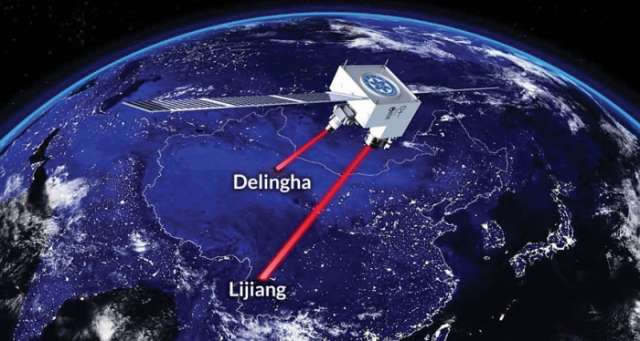“It’s a huge achievement for quantum entanglement and quantum science,” says physicist Thomas Jennewein of the University of Waterloo in Canada.
Scientists have previously beamed photons up to a satellite and back again (SN Online: 6/5/16), but those particles were not entangled. Until now, no one had distributed entangled particles from space. “China is now clearly taking the world leadership in this area of quantum communication,” Jennewein says.
The technique is expected to have major technological applications. “This experiment is really important for the development of a future quantum internet,” says Anton Zeilinger, a physicist at the University of Vienna. Such a network would allow for ultrasecure communications and could connect quantum computers across the globe (SN: 10/15/16, p. 13).
An ethereal bond between two particles, entanglement is the most essential ingredient of a quantum network. Entangled particles can’t be described independently; instead, they form one unit, even when separated by large distances. Measuring one entangled particle immediately reveals the state of the other. To perform quantum communication, scientists send entangled photons from place to place. But photons can only travel so far through air or optical fibers before the material absorbs the particles, limiting the distance over which communication is possible. In the emptiness of space, however, photons can travel much farther.
Using the satellite, named Micius after an ancient Chinese philosopher, the researchers beamed intertwined photon pairs down to the cities of Delingha in northern China and Lijiang in southern China. There, telescopes aimed at the satellite detected the particles. To confirm that the particles were entangled, and that the weird qualities of quantum mechanics held, the researchers used the photon pairs to perform a Bell test (SN: 9/19/15, p. 12), which analyzes correlations between the two particles. The test reconfirmed the odd physics of the supersmall, at a larger distance than ever before.
To perform the experiment, the researchers had to update their quantum equipment to make it work in space. That technological achievement is amazing, says physicist Harald Weinfurter of Ludwig-Maximilians-Universität in Munich. “It's a huge step from the laboratory experiments to equipment which really works on a satellite,” he says. In space, sensitive components must deal with inhospitable conditions such as fluctuating temperatures and vibrations. Plus, to fit on the satellite, the whole package must be small and lightweight.
Detecting the photons is likewise daunting. Beacon lasers helped researchers point the ground-based telescopes in the right direction to catch the photons, as the satellite zipped past, 500 kilometers above Earth’s surface. The accuracy the researchers achieved is like pinpointing a human hair on the ground from the top of the Eiffel Tower.
In the future, researchers suggest, quantum entanglement will be an important resource for communicating across the globe. “Today we pay bills: electrical bills, water bills,” says coauthor Chao-Yang Lu, a physicist at the University of Science and Technology of China in Hefei. With quantum entanglement such a basic requirement of quantum communication, “maybe someday we will need to pay some entanglement bills.”
More about: #science
















































